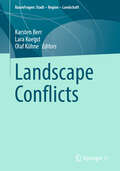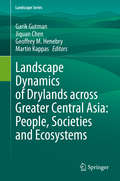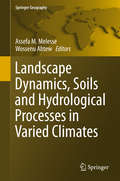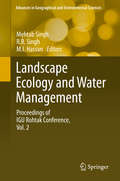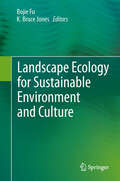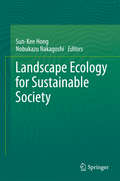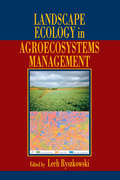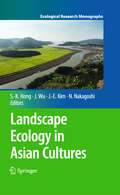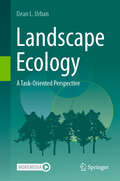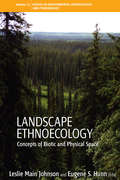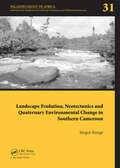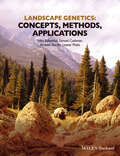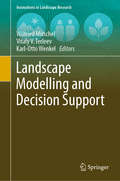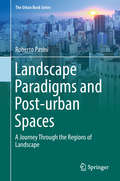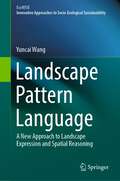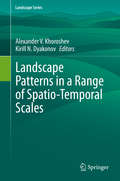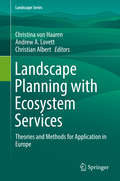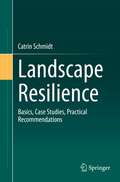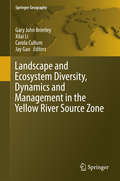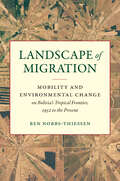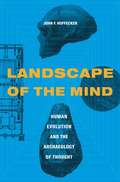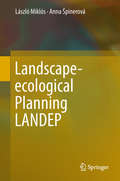- Table View
- List View
Landscape Conflicts (RaumFragen: Stadt – Region – Landschaft)
by Olaf Kühne Karsten Berr Lara KoegstLandscape conflicts, for example in connection with / in view of the energy transition, climate policy, transport policy, nature conservation, the extraction of mineral raw materials, the design of urban landscapes or tourism are potentially associated with high economic, social and political costs even before a possible escalation. It is therefore undoubtedly useful to gain a better understanding of landscape-related conflicts in terms of their causes, their course, their dynamics, their inherent logic and possible regulatory procedures. Frequently, such conflicts manifest themselves in particular in different claims and aspired or arrogated interpretative sovereignties concerning what can or may be considered together as 'landscape' (here understood as a special case to 'space'), and these conflicts are not limited to the economic dimension, but they also ignite in social, political and cultural, often also in aesthetic and moral questions. The contributions to this anthology therefore focus on the question of how landscape conflicts can be seen as a productive social normality and be brought to a non-violent and not necessarily consensual settlement.
Landscape Dynamics of Drylands across Greater Central Asia: People, Societies and Ecosystems (Landscape Series #17)
by Martin Kappas Garik Gutman Jiquan Chen Geoffrey M. HenebryThis volume is a compilation of studies on interactions of changes in land cover, land use and climate with people, societies and ecosystems in drylands of Greater Central Asia. It explores the effects of collapse of socialist governance and management systems on land use in various parts of Central Asia, including former Soviet Union republics, Mongolia and northern drylands of China. Often, regional land-atmosphere feedbacks may have large global importance. Remote sensing is a primary tool in studying vast dryland territories where in situ observations are sporadic. State-of-the-art methods of satellite remote sensing combined with GIS and models are used to tackle science questions and provide an outlook of current changes at land surface and potential scenarios for the future. In 10 chapters, contributing authors cover topics such as water resources, effects of institutional changes on urban centers and agriculture, landscape dynamics, and the primary drivers of environmental changes in dryland environment. Satellite observations that have accumulated during the last five decades provide a rich time series of the dynamic land surface, enabling systematic analysis of changes in land cover and land use from space. The book is a truly international effort by a team of scientists from the U.S., Europe and Central Asia. It is directed at the broad science community including graduate students, academics and other professionals at all levels within natural and social sciences. In particular, it will appeal to geographers, environmental and social scientists, economists, agricultural scientists, and remote sensing specialists.
Landscape Dynamics, Soils and Hydrological Processes in Varied Climates
by Wossenu Abtew Assefa M. MelesseThe book presents the processes governing the dynamics of landscapes, soils and sediments, water and energy under different climatic regions using studies conducted in varied climatic zones including arid, semi-arid, humid and wet regions. The spatiotemporal availability of the processes and fluxes and their linkage to the environment, land, soil and water management are presented at various scales. Spatial scales including laboratory, field, watershed, river basin and regions are represented. The effect of tillage operations and land management on soil physical characteristics and soil moisture is discussed. The book has 35 chapters in seven sections: 1) Landscape and Land Cover Dynamics, 2) Rainfall-Runoff Processes, 3) Floods and Hydrological Processes 4) Groundwater Flow and Aquifer Management, 5) Sediment Dynamics and Soil Management, 6) Climate change impact on vegetation, sediment and water dynamics, and 7) Water and Watershed Management.
Landscape Ecology and Water Management
by R. B. Singh Mehtab Singh M. I. HassanThe over-exploitation of important earth resources such as land and water has led to a number of environment-related problems the world over. At the same time, land-use change caused by various human activities has led to extinction of many plant and animal habitats and species. In this context, the relevance of biodiversity for human survival is becoming a major international political issue as scientific evidence builds on the global health implications of biodiversity loss. These issues are closely linked with the issue of climate change, as many of the health risks due to climate change are associated with rapid degradation of biodiversity. This present work focuses on holistic natural resource-based spatio-temporal planning, development and management and considers them as essential to save the degraded ecosystem for sustainable resource management. Contributions are compiled in two volumes: 1. Climate Change and Biodiversity and 2. Landscape Ecology and Water Management. Geoinformatics along with its tools such as remote sensing and Geographical Information Systems (GIS) have been used in assessing the results of various environmental problems both physical and social. These volumes will be useful for geographers, geoscientists, hydrologists, landscape ecologists, environmentalists, engineers, planners and policy makers.
Landscape Ecology for Sustainable Environment and Culture
by Bojie Fu Bruce Jones KClimate change and the pressures of escalating human demands on the environment have had increasing impacts on landscapes across the world. In this book, world-class scholars discuss current and pressing issues regarding the landscape, landscape ecology, social and economic development, and adaptive management. Topics include the interaction between landscapes and ecological processes, landscape modeling, the application of landscape ecology in understanding cultural landscapes, biodiversity, climate change, landscape services, landscape planning, and adaptive management to provide a comprehensive view that allows readers to form their own opinions. Professor Bojie Fu is an Academician of Chinese Academy of Sciences and Chair of scientific committee at the Research Center for Eco-Environmental Sciences, Chinese Academy of Sciences, Beijing, China. Professor K. Bruce Jones is the Executive Director for Earth and Ecosystem Sciences Division at Desert Research Institute, University of Nevada, Las Vegas, USA.
Landscape Ecology for Sustainable Society
by Sun-Kee Hong Nobukazu NakagoshiThe research category of the landscape ecology, which researches the structure, functions, and the spatio-temporal changes of the ecological landscapes, has now been contributing to the human life and the shifts of the socio-economic paradigm. Global warming has been influencing the universal life patterns of the mankind which have been maintained in the past several hundreds of years. And it has been having the influences on the international social problems and economic problems. Although the diverse plans for adapting to the climate changes have been the topics of the conservations among the ecologists internationally, it is the reality that the speed of the changes of the environment has been quicker than the time it takes to complete the solutions. In order to maintain the sustainable earth and the sustainable society, the role of the landscape ecology has been coming to the fore. Especially, the theories and the methodologies of the landscape ecology have been applied to the multidisciplinary researches by going beyond the research category of ecology, including the maximization of the efficiencies of the land spaces, the management of the ecological space (habitats) in which the biological diversity can be maintained, the utilization of the resources that are absolutely needed by the human beings (Here, it is compressed to water, energy, and food), etc. and until reaching the human society. It is considered that, to that extent, the utilizations and the applications of the landscape ecology are very much needed for the diagnoses and the evaluations of the global environmental problems which have been proceeded with rapidly in the modernity.This book is not comprised of any general remarks that explain the theories and the methods of the landscape ecology. Already, based on the basic theories of the landscape ecology, the writers have conducted the investigations on the farm villages, the cities, and the coastal ecosystems. And, through the space analyses and interpretations, the structure and functions of the landscapes were analyzed. Of course, in this book, too, the diverse ecosystems and the landscape ecological methodologies regarding the land use have been presented. However, the core of this book focuses more on what role the landscape ecology must play for the materialization of a sustainable society in the future. At the farm villages, the sustainable agriculture will be presented, and, at the cities, the discussions on the green networks and the energies will be proceeded with. Also, regarding the coasts and the seas, a thesis on the safety of the life zones of the residents adjacent to the sea and on the conservation of the island ecosystems will be presented. The sustainable society is a system that is formed by having the sustainable development as a basis. It is considered to be one aspect within a kind of a sustainable process with regard to which the natural world and the human world coexist and are in a symbiotic relationship harmoniously. In order to maintain the biodiversity, the reasonable adjustments of the human activities, like the use of the resources, are absolutely needed. Without the biological resources, the cultural diversity of the human beings, too, cannot exist. Consequentially, recently and internationally, there are a lot of the case examples that express the biocultural diversity by linking the biological diversity with the cultural diversity. In this book, the role of the landscape ecology as an academic link which can connect the two possible, if possible, is highly expected. It is, indeed, the biocultural landscape. It can be said that this concept, also, is the interconnection of the multidisciplinary spaces that must be dealt with in the modern landscape ecology. Through this book, it is intended to present a new directionality which can contribute to the sustainable society at the same time as the organization of the theories and the methods of the landscape ecology.
Landscape Ecology in Agroecosystems Management
by Lech RyszkowskiSuccessful management of agricultural landscapes depends on the recognition of the relationships between the processes and the structures that maintain the system. The rapidly growing science of Landscape Ecology quantifies the ways these ecosystems interact and establishes a link between the activities in one region and repercussions in another. A
Landscape Ecology in Asian Cultures
by Sun-Kee Hong Jianguo Wu Jae-Eun Kim Nobukazu NakagoshiCultural landscapes are a product of the interactions between humans and natural settings. They are landscapes and seascapes that are shaped by human history and land use. Socioeconomic processes especially, but also environmental changes and natural disturbances, are some of the forces that make up landscape dynamics. To understand and manage such complex landscapes, interdisciplinary and transdisciplinary approaches are necessary, emphasizing the integration of natural and social sciences and considering multiple landscape functions. The spatial patterns of Asian landscapes are strongly related to human activities and their impacts. Anthropogenic patterns and processes have created numerous traditional cultural landscapes throughout the region, and understanding them requires indigenous knowledge. Cultural landscape ecology from a uniquely Asian perspective is explored in this book, as are the management of landscapes and land-use policies. Human-dominated landscapes with long traditions, such as those described herein, provide useful information for all ecologists, not only in Asia, to better understand the human-environmental relationship and landscape sustainability.
Landscape Ecology in Theory and Practice
by Robert H. Gardner Monica G. TurnerThis work provides in-depth analysis of the origins of landscape ecology and its close alignment with the understanding of scale, the causes of landscape pattern, and the interactions of spatial pattern with a variety of ecological processes. The text covers the quantitative approaches that are applied widely in landscape studies, with emphasis on their appropriate use and interpretation. The field of landscape ecology has grown rapidly during this period, its concepts and methods have matured, and the published literature has increased exponentially. Landscape research has enhanced understanding of the causes and consequences of spatial heterogeneity and how these vary with scale, and they have influenced the management of natural and human-dominated landscapes. Landscape ecology is now considered mainstream, and the approaches are widely used in many branches of ecology and are applied not only in terrestrial settings but also in aquatic and marine systems. In response to these rapid developments, an updated edition of Landscape Ecology in Theory and Practice provides a synthetic overview of landscape ecology, including its development, the methods and techniques that are employed, the major questions addressed, and the insights that have been gained. "
Landscape Ecology: A Task-Oriented Perspective
by Dean L UrbanThis is methods/tools textbook that covers the fundamental tasks in research and management at the landscape scale. It brings together tools from a range of disciplines and presents them in a natural workflow that a practitioner can appreciate. Alternative texts cover a narrower range of topics and/or present the information without reference to a natural workflow. The book begins with 2 fundamental applications that introduce the scope and challenges of working at the landscape scales (sampling design and species distribution modeling). These motivate several chapters that ‘digress’ to cover the primary tools that ecologists use to work with multivariate and spatial data. The book then returns to applications including site prioritization, interpreting (and forecasting) landscape change, and integrated assessment. The tasks themselves follow a logical workflow of collecting and analyzing data, applying the analyses to management decisions, and interpreting the outcomes of these decisions in an integrated framework. This book stems from two graduate-level courses in Landscape Ecology taught at the Nicholas School of the Environment at Duke University. The subject has evolved over time, from a concepts-based overview of what landscape ecology is, to a more applied practicum on how one does landscape ecology. As landscape ecology has matured as a discipline, its perspectives on spatial heterogeneity and scale have begun to permeate into a wide range of other fields including conservation biology, ecosystem management, and ecological restoration. Thus, this textbook will bring students from diverse backgrounds to a common level of understanding and will prepare them with the practical knowledge for a career in conservation and ecosystem management.
Landscape Ethnoecology
by Leslie Main Johnson Eugene S. HunnAlthough anthropologists and cultural geographers have explored "place" in various senses, little cross-cultural examination of "kinds of place," or ecotopes, has been presented from an ethno-ecological perspective. In this volume, indigenous and local understandings of landscape are investigated in order to better understand how human communities relate to their terrestrial and aquatic resources. The contributors go beyond the traditional ecological knowledge (TEK) literature and offer valuable insights on ecology and on land and resources management, emphasizing the perception of landscape above the level of species and their folk classification. Focusing on the ways traditional people perceive and manage land and biotic resources within diverse regional and cultural settings, the contributors address theoretical issues and present case studies from North America, Mexico, Amazonia, tropical Asia, Africa and Europe.
Landscape Evolution, Neotectonics and Quaternary Environmental Change in Southern Cameroon: Palaeoecology of Africa Vol. 31, An International Yearbook of Landscape Evolution and Palaeoenvironments (Palaeoecology of Africa)
by Jürgen RungeFounded in 1966, the internationally recognized and acclaimed SeriesPalaeoecology of Africa publishes interdisciplinary scientific papers on landscape evolution and on former environments of the African continent. Beginning with topics such as changes in climate and vegetation cover, the papers expand horizons and interconnections to various typ
Landscape Genetics: Concepts, Methods, Applications
by Niko Balkenhol Samuel Cushman Andrew Storfer Lisette WaitsDespite the substantial interest in landscape genetics from the scientific community, learning about the concepts and methods underlying the field remains very challenging. The reason for this is the highly interdisciplinary nature of the field, which combines population genetics, landscape ecology, and spatial statistics. These fields have traditionally been treated separately in classes and textbooks, and very few scientists have received the interdisciplinary training necessary to efficiently teach or apply the diversity of techniques encompassed by landscape genetics. To address the current knowledge gap, this book provides the first in depth treatment of landscape genetics in a single volume. Specifically, this book delivers fundamental concepts and methods underlying the field, covering particularly important analytical methods in detail, and presenting empirical and theoretical applications of landscape genetics for a variety of environments and species. Consistent with the interdisciplinary nature of landscape genetics, the book combines an introductory, textbook like section with additional sections on advanced topics and applications that are more typical of edited volumes. The chapter topics and the expertise of the authors and the editorial team make the book a standard reference for anyone interested in landscape genetics. The book includes contributions from many of the leading researchers in landscape genetics. The group of scientists we have assembled has worked on several collaborative projects over the last years, including a large number of peer reviewed papers, several landscape genetics workshops at international conferences, and a distributed graduate seminar on landscape genetics. Based on the experiences gained during these collaborative teaching and research activities, the book includes chapters that synthesize fundamental concepts and methods underlying landscape genetics (Part 1), chapters on advanced topics that deserve a more in depth treatment (Part 2), and chapters illustrating the use of concepts and methods in empirical applications (Part 3). This structure ensures a high usefulness of the book for beginning landscape geneticists and experienced researchers alike, so that it has a broad target audience. At least one of the four co editors is involved in almost every chapter of the book, thereby ensuring a high consistency and coherency among chapters.
Landscape Modelling and Decision Support (Innovations in Landscape Research)
by Wilfried Mirschel Vitaly V. Terleev Karl-Otto WenkelThis book contributes to a deeper understanding of landscape and regional modelling in general, and its broad range of facets with respect to various landscape parameters. It presents model approaches for a number of ecological and socio-economic landscape indicators, and also describes spatial decision support systems (DSS), frameworks, and model-based tools, which are prerequisites for deriving sustainable decision and solution strategies for the protection of comprehensively functioning landscapes. While it mainly focuses on the latest research findings in regional modelling and DSS in Europe, it also highlights the work of scientists from Russia. The book is intended for landscape modellers, scientists from various fields of landscape research, university teaching staff, and experts in landscape planning and management, landscape conservation and landscape policy.
Landscape Paradigms and Post-urban Spaces: A Journey Through the Regions of Landscape (The Urban Book Series)
by Roberto PasiniThis book presents: 1) an urban-studies panorama on the emergence of a built/landscape continuum following the anthropic expansion at the geographic scale and the consequent demise of the city/country divide; 2) an in-depth theoretical analysis of disparate landscape constructs, culminating in the proposal of a comprehensive spatial paradigm addressing both manmade and natural contexts; 3) the in-situ transcription of the proposed spatial paradigm into a landscape installation implementing a territorial narrative in the Sierra Madre Oriental of Mexico. Foreword by Peter G. Rowe and afterword by Elisa C. Cattaneo.By virtue of its openness, fluidity, and volatility, fluctuating between heterogeneity and diversity, today’s built/landscape continuum exhibits analogies with distinct notions of landscape. The book determines an open-ended classification of contemporary space-making strategies exceeding the urban and metropolitan ambit, through a comparative anatomy of global case studies ranging from hard to soft: geotechnics or applied geographies, machinic micro-ecologies, aesthetic prostheses for operative metabolism, cybernetic utopias, atmospheric assemblages, psychic spheres, creole horizons, semiotic landscapes, geopolitical landscapes, geophilosophical excavations. The proposed spatial paradigm, accommodating aggregates of artificial and living systems, physical and mental spaces, and machinic and cultural landscapes, intends to reconcile the traditionally opposed ‘scientific-cognitive-metabolist’ and ‘cultural-geophilosophical-territorialist’ visions of the landscape. The resulting model transcends the exhausted myths of urban space, metropolitanism, and their filiations, in favor of a new form of urbanity and its attributes. Parts of the work were developed in the frame of research projects of Universidad de Monterrey and Parque Ecológico Chipinque and the IDAUP of UniFE and Polis.The target audience of the book is researchers, teachers, and advanced students engaged in landscape and urban studies with a prevalent focus on theory. The book can also benefit professional and institutional audiences looking for ethical/methodological orientation.
Landscape Pattern Language: A New Approach to Landscape Expression and Spatial Reasoning (EcoWISE)
by Yuncai WangThis book presents a landscape pattern language framework for describing landscape spaces and offers a new approach to landscape expression and spatial reasoning. In addition to describing a conceptual model of landscape pattern language and its inner logical connections, the book discusses the functionality of landscape pattern language from both local and universal perspectives—effectively demonstrating that it can be used to highlight the individuality and characteristics of landscape space shaping. Given its scope, the book offers a valuable resource for all graduate students, lecturers, researchers, and practitioners in the areas of landscape architecture, landscape planning, and regional planning, especially ecological planning and design.
Landscape Patterns in a Range of Spatio-Temporal Scales (Landscape Series #26)
by Alexander V. Khoroshev Kirill N. DyakonovThis book presents the polycentric and multiscale view of landscape which has been developed in Russia within a framework of physical geography since the early twentieth century. The authors develop the ideas of hierarchical organization of a landscape and strong relationships between abiotic and biotic components with equal attention to both vertical fluxes and lateral transfer. Three-dimensional representation of landscape involves strong emphasis on abiotic drivers of pattern development including relief, geological structures and runoff. The objective of this book is to demonstrate the multiplicity of models and multiscale approach to description and explanation of landscape pattern, functioning, dynamics, and evolution. The contributions deal with various hierarchical levels ranging from within-unit interior variability to between-units interaction at landscape level, as well as regional and supra-regional zonal patterns. Divided into 8 clear parts, the 28 chapters treat spatial pattern in one of the following aspects: indicator of actual matter and energy flows control over actual processes including disturbance expansion as well as determinant of future development indicator of genesis and prerequisite for future trends driver for short-term dynamics of processes response to climatic and anthropogenic influences factor of settlement network and land use adaptation at various historical epochs framework for actual land use spatial arrangement. This contributed volume is written for researchers and students in the field of landscape ecology, physical geography, environmental impact assessment, and ecological planning.
Landscape Planning with Ecosystem Services: Theories and Methods for Application in Europe (Landscape Series #24)
by Christina Von Haaren Andrew A. Lovett Christian AlbertHuman well-being depends in many ways on maintaining the stock of natural resources which deliver the services from which human’s benefit. However, these resources and flows of services are increasingly threatened by unsustainable and competing land uses. Particular threats exist to those public goods whose values are not well-represented in markets or whose deterioration will only affect future generations. As market forces alone are not sufficient, effective means for local and regional planning are needed in order to safeguard scarce natural resources, coordinate land uses and create sustainable landscape structures. This book argues that a solution to such challenges in Europe can be found by merging the landscape planning tradition with ecosystem services concepts. Landscape planning has strengths in recognition of public benefits and implementation mechanisms, while the ecosystem services approach makes the connection between the status of natural assets and human well-being more explicit. It can also provide an economic perspective, focused on individual preferences and benefits, which helps validate the acceptability of environmental planning goals. Thus linking landscape planning and ecosystem services provides a two-way benefit, creating a usable science to meet the needs of local and regional decision making. The book is structured around the Driving forces-Pressures-States-Impacts-Responses framework, providing an introduction to relevant concepts, methodologies and techniques. It presents a new, ecosystem services-informed, approach to landscape planning that constitutes both a framework and toolbox for students and practitioners to address the environmental and landscape challenges of 21st century Europe.
Landscape Resilience: Basics, Case Studies, Practical Recommendations
by Catrin SchmidtThis book explains what makes landscapes resilient. Why are some landscapes able to recover quickly from disruptive events or crises, while others are completely thrown off balance for the foreseeable future? The author sets out in search of the influencing factors and conditional structures of landscape resilience and not only evaluates the current state of the art, but also explores landscapes around the globe that could not be more contrasting: from arid agricultural landscapes to boreal forest landscapes, from atolls to saline landscapes, from terraced landscapes to cities. Just as diverse as the landscape types are the factors considered that can put landscapes under stress. However diverse the case studies are in detail, their fascinating mosaic shows at the same time that there are overarching principles that can be used to increase the resilience of landscapes in a targeted way, so that landscapes emerge from crises strengthened rather than weakened. This book is a translation of the original German 1st edition Landschaftliche Resilienz by Catrin Schmidt, published by Springer-Verlag GmbH Germany, part of Springer Nature in 2020. The translation was done with the help of artificial intelligence (machine translation by the service DeepL.com). A subsequent human revision was done primarily in terms of content, so that the book will read stylistically differently from a conventional translation. Springer Nature works continuously to further the development of tools for the production of books and on the related technologies to support the authors.
Landscape and Ecosystem Diversity, Dynamics and Management in the Yellow River Source Zone
by Gary John Brierley Xilai Li Carola Cullum Jay GaoThis book offers a comprehensive review of the landscapes and ecosystems of the Upper Yellow River. It focuses on landscapes as a platform for considering environmental values and issues across the region. The book is based on extensive field-based analyses, applications, and photographs.
Landscape as a Geosystem
by László Miklós Anna Špinerová Erika Kočická Zita Izakovičová Dušan Kočický Andrea Diviaková Viktória MiklósováThe book analyses the landscape as a geosystem in all its complexity (from the abiotic environment, and land use to socio-economic character) as an integrated natural resource, as society’s life space, as well as an object of planning and decision making on sustainable land use. It presents the landscape properties in the form of databases that comply with the INSPIRE Directive 2007/2/EC (INSPIRE – Infrastructure for Spatial InfoRmation in Europe) requirements, which can be used for a variety of purposes and can serve as a national spatial information database for the needs of applied landscape-ecological research and real-world spatial planning processes. The book also provides overview legends with complete domain values of selected attributes of all three landscape structures (primary, secondary and tertiary) routinely used in Slovakia. Lastly, the book offers an example of the construction and mapping of geocomplexes as well as the database creation on the model territory at the regional level.
Landscape of Migration: Mobility and Environmental Change on Bolivia's Tropical Frontier, 1952 to the Present (Flows, Migrations, and Exchanges)
by Ben Nobbs-ThiessenIn the wake of a 1952 revolution, leaders of Bolivia's National Revolutionary Movement (MNR) embarked on a program of internal colonization known as the "March to the East." In an impoverished country dependent on highland mining, the MNR sought to convert the nation's vast "undeveloped" Amazonian frontier into farmland, hoping to achieve food security, territorial integrity, and demographic balance. To do so, they encouraged hundreds of thousands of Indigenous Bolivians to relocate from the "overcrowded" Andes to the tropical lowlands, but also welcomed surprising transnational migrant streams, including horse-and-buggy Mennonites from Mexico and displaced Okinawans from across the Pacific.Ben Nobbs-Thiessen details the multifaceted results of these migrations on the environment of the South American interior. As he reveals, one of the "migrants" with the greatest impact was the soybean, which Bolivia embraced as a profitable cash crop while eschewing earlier goals of food security, creating a new model for extractive export agriculture. Half a century of colonization would transform the small regional capital of Santa Cruz de la Sierra into Bolivia's largest city, and the diverging stories of Andean, Mennonite, and Okinawan migrants complicate our understandings of tradition, modernity, foreignness, and belonging in the heart of a rising agro-industrial empire.
Landscape of Next Generation Sequencing Using Pattern Recognition: Performance Analysis and Applications (River Publishers Series in Biotechnology and Medical Research)
by Loveleen Gaur Mingqiang Wang Saurav Mallik Soumita Seth Tapas BhadraThis book focuses on an eminent technology called next generation sequencing (NGS) which has entirely changed the procedure of examining organisms and will have a great impact on biomedical research and disease diagnosis. Numerous computational challenges have been brought on by the rapid advancement of large-scale next-generation sequencing (NGS) technologies and their application. The term ""biomedical imaging"" refers to the use of a variety of imaging techniques (such as X-rays, CT scans, MRIs, ultrasounds, etc.) to get images of the interior organs of a human being for potential diagnostic, treatment planning, follow-up, and surgical purposes. In these circumstances, deep learning, a new learning method that uses multi-layered artificial neural networks (ANNs) for unsupervised, supervised, and semi-supervised learning, has attracted a lot of interest for applications to NGS and imaging, even when both of these data are used for the same group of patients.The three main research phenomena in biomedical research are disease classification, feature dimension reduction, and heterogeneity. AI approaches are used by clinical researchers to efficiently analyse extremely complicated biomedical datasets (e.g., multi-omic datasets. With the use of NGS data and biomedical imaging of various human organs, researchers may predict diseases using a variety of deep learning models. Unparalleled prospects to improve the work of radiologists, clinicians, and biomedical researchers, speed up disease detection and diagnosis, reduce treatment costs, and improve public health are presented by using deep learning models in disease prediction using NGS and biomedical imaging. This book influences a variety of critical disease data and medical images.
Landscape of the Mind: Human Evolution and the Archaeology of Thought
by John HoffeckerIn Landscape of the Mind, John F. Hoffecker explores the origin and growth of the human mind, drawing on archaeology, history, and the fossil record. He suggests that, as an indirect result of bipedal locomotion, early humans developed a feedback relationship among their hands, brains, and tools that evolved into the capacity to externalize thoughts in the form of shaped stone objects. When anatomically modern humans evolved a parallel capacity to externalize thoughts as symbolic language, individual brains within social groups became integrated into a "neocortical Internet," or super-brain, giving birth to the mind.Noting that archaeological traces of symbolism coincide with evidence of the ability to generate novel technology, Hoffecker contends that human creativity, as well as higher order consciousness, is a product of the superbrain. He equates the subsequent growth of the mind with human history, which began in Africa more than 50,000 years ago. As anatomically modern humans spread across the globe, adapting to a variety of climates and habitats, they redesigned themselves technologically and created alternative realities through tools, language, and art. Hoffecker connects the rise of civilization to a hierarchical reorganization of the super-brain, triggered by explosive population growth. Subsequent human history reflects to varying degrees the suppression of the mind's creative powers by the rigid hierarchies of nationstates and empires, constraining the further accumulation of knowledge. The modern world emerged after 1200 from the fragments of the Roman Empire, whose collapse had eliminated a central authority that could thwart innovation. Hoffecker concludes with speculation about the possibility of artificial intelligence and the consequences of a mind liberated from its organic antecedents to exist in an independent, nonbiological form.
Landscape-ecological Planning LANDEP
by László Miklós Anna ŠpinerováThis book provides a comprehensive description of the landscape-ecological planning system LANDEP, and introduces the methodical procedure. LANDEP was developed at the Institute of Landscape Ecology of Slovak Academy of Sciences in Bratislava and has been applied in various planning processes at home and abroad. Despite the fact that the LANDEP methodology was defined in 1979, the methodological content, sequence of procedures and the application of concept in practice are still valid. The first two steps – analyses and syntheses – have the nature of fundamental research and result in the design and characteristics of complex landscape-ecological-spatial units. The final two steps – evaluations and proposals – address the needs of planning practice. The intermediate step – interpretations – has the character of applied research and forms the arguments and criteria for the assessment of landscape for its utilisation by humans.
